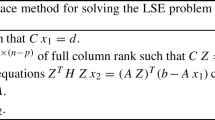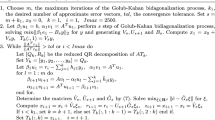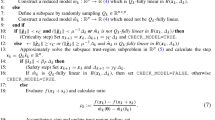Abstract
LSQR uses the Golub-Kahan bidiagonalization process to solve sparse least-squares problems with and without regularization. In some cases, projections of the right-hand side vector are required, rather than the least-squares solution itself. We show that projections may be obtained from the bidiagonalization as linear combinations of (the-oretically) orthogonal vectors. Even the least-squares solution may be obtained from orthogonal vectors, perhaps more accurately than the usual LSQR solution. (However, LSQR has proved equally good in all examples so far.)
Similar content being viewed by others
References
Å. Björck,Conjugate gradient methods for sparse least squares problems, unpublished notes, Stanford University, 1979.
Å. Björck,A bidiagonalization algorithm for solving ill-posed systems of linear equations, Report LITH-MAT-R-80-33, Dept. of Mathematics, Linköping University, Linköping, Sweden, 1980.
Å. Björck, T. Elfving, and Z. Strakoŝ,Stability of conjugate gradient and Lanczos methods for linear least squares problems, SIAM J. Matrix, Anal. Appl., to appear.
J. E. Craig,The N-step iteration procedures, J. Math. and Phys.,34, 1 (1955), pp. 64–73.
D. K. Faddeev and V. N. Faddeeva,Computational Methods of Linear Algebra, Freeman, London, 1963.
G. H. Golub and W. Kahan,Calculating the singular values and pseudoinverse of a matrix, SIAM J. Numer. Anal., 2 (1965), pp. 205–224.
G. H. Golub and C. F. Van Loan,Matrix Computations, Second Edition, The Johns Hopkins University Press, Baltimore and London, 1989.
A. Greenbaum,Estimating the attainable accuracy of recursively computed residual methods, SIAM J. Matrix Anal. Appl., to appear.
M. R. Hestenes and E. Stiefel,Methods of conjugate gradients for solving linear systems. J. Res. Nat. Bur. Stds., B49 (1952), pp. 409–436.
C. C. Paige,Bidiagonalization of matrices and solution of linear equations, SIAM J. Numer. Anal., 11 (1974), pp. 197–209.
C. C. Paige and M. A. Saunders,LSQR: An algorithm for sparse linear equations and sparse least squares, ACM Trans. Math. Software, 8(1) (1982), pp. 43–71.
C. C. Paige and M. A. Saunders,Algorithm 583. LSQR: Sparse linear equations and least squares problems, ACM Trans. Math. Software, 8(2), (1982), pp. 195–209.
M. A. Saunders,Solution of sparse rectangular systems using LSQR and CRAIG, BIT, 35 (1995), pp. 588–604.
Author information
Authors and Affiliations
Additional information
Partially supported by Department of Energy grant DE-FG03-92ER25117, National Science Foundation grants DMI-9204208 and DMI-9500668, and Office of Naval Research grants N00014-90-J-1242 and N00014-96-1-0274.
Rights and permissions
About this article
Cite this article
Saunders, M.A. Computing projections with LSQR. Bit Numer Math 37, 96–104 (1997). https://doi.org/10.1007/BF02510175
Received:
Revised:
Issue Date:
DOI: https://doi.org/10.1007/BF02510175




